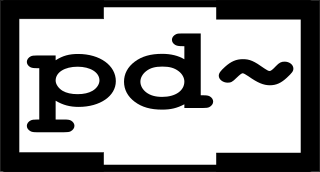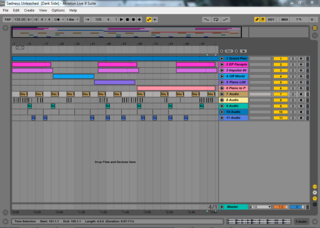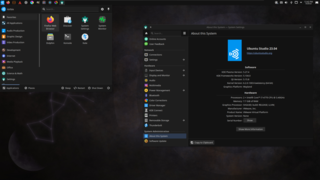Related Research Articles

MIDI is a technical standard that describes a communication protocol, digital interface, and electrical connectors that connect a wide variety of electronic musical instruments, computers, and related audio devices for playing, editing, and recording music.
A music sequencer is a device or application software that can record, edit, or play back music, by handling note and performance information in several forms, typically CV/Gate, MIDI, or Open Sound Control, and possibly audio and automation data for digital audio workstations (DAWs) and plug-ins.

Sound Blaster is a family of sound cards and audio peripherals designed by Singaporean technology company Creative Technology. The first Sound Blaster card was introduced in 1989.

FL Studio is a digital audio workstation (DAW) developed by the Belgian company Image-Line. It features a graphical user interface with a pattern-based music sequencer. It is available in four different editions for Microsoft Windows and macOS.

Cubase is a digital audio workstation (DAW) developed by Steinberg for music and MIDI recording, arranging and editing. The first version, which was originally only a MIDI sequencer and ran on the Atari ST computer, was released in 1989. Cut-down versions of Cubase are included with almost all Yamaha audio and MIDI hardware, as well as hardware from other manufacturers. These versions can be upgraded to a more advanced version at a discount.

Pro Tools is a digital audio workstation (DAW) developed and released by Avid Technology for Microsoft Windows and macOS. It is used for music creation and production, sound for picture and, more generally, sound recording, editing, and mastering processes.

A digital audio workstation is an electronic device or application software used for recording, editing and producing audio files. DAWs come in a wide variety of configurations from a single software program on a laptop, to an integrated stand-alone unit, all the way to a highly complex configuration of numerous components controlled by a central computer. Regardless of configuration, modern DAWs have a central interface that allows the user to alter and mix multiple recordings and tracks into a final produced piece.

Audio editing software is any software or computer program which allows editing and generating audio data. Audio editing software can be implemented completely or partly as a library, as a computer application, as a web application, or as a loadable kernel module. Wave editors are digital audio editors. There are many sources of software available to perform this function. Most can edit music, apply effects and filters, and adjust stereo channels.

Renoise is a digital audio workstation (DAW) based upon the heritage and development of tracker software. Its primary use is the composition of music using sound samples, soft synths, and effects plug-ins. It is also able to interface with MIDI and OSC equipment. The main difference between Renoise and other music software is the characteristic vertical timeline sequencer used by tracking software.

Max, also known as Max/MSP/Jitter, is a visual programming language for music and multimedia developed and maintained by San Francisco-based software company Cycling '74. Over its more than thirty-year history, it has been used by composers, performers, software designers, researchers, and artists to create recordings, performances, and installations.

Pure Data (Pd) is a visual programming language developed by Miller Puckette in the 1990s for creating interactive computer music and multimedia works. While Puckette is the main author of the program, Pd is an open-source project with a large developer base working on new extensions. It is released under BSD-3-Clause. It runs on Linux, MacOS, iOS, Android and Windows. Ports exist for FreeBSD and IRIX.

Ableton Live, also known as Live or sometimes colloquially as "Ableton", is a digital audio workstation for macOS and Windows developed by the German company Ableton.
Ableton AG is a German music software company that produces and distributes the production and performance program Ableton Live and a collection of related instruments and sample libraries, as well as their own hardware controller Ableton Push. Ableton's office is located in the Prenzlauer Berg district of Berlin, Germany, with a second office in Pasadena, California.
The Roland SC-55 is a GS MIDI sound module released in 1991 by Roland. The SC-55 was the first sound module to incorporate the new General MIDI standard. It was the first in the Roland Sound Canvas series.

LMMS is a digital audio workstation application program. It allows music to be produced by arranging samples, synthesizing sounds, entering notes via computer keyboard or mouse or by playing on a MIDI keyboard, and combining the features of trackers and sequencers. It is free and open source software, written in Qt and released under GPL-2.0-or-later.

Ubuntu Studio is a recognized flavor of the Ubuntu Linux distribution, which is geared to general multimedia production. The original version, based on Ubuntu 7.04, was released on 10 May 2007.

Logic Studio is a discontinued professional music production suite by Apple Inc. The first version of Logic Studio was unveiled on September 12, 2007. It claims to be the largest collection of modeled instruments, sampler instruments, effect plug-ins, and audio loops ever put in a single application.

Bidule is a commercial software application for the creation of interactive computer music and multimedia produced by the Canadian company Plogue Arts and Technology. It runs on both Windows and Mac computers.

Notion, previously stylized as NOTION, is a computer software program for music composition and performance, created by NOTION Music of Greensboro, North Carolina. NOTION Music was acquired by PreSonus in 2013 which in turn was acquired by Fender Musical Instruments in 2021. Notion 6 is available on Microsoft Windows and macOS, and Notion Mobile is available for Windows, macOS, iOS, Android and Fire OS.
References
- AudioMulch website – info page. Retrieved on 2009-01-28
- AudioMulch website – discography. Retrieved on 2009-01-28
- Clatterbox website. Retrieved on 2009-01-28
- Dugan, S. (2006), "Girl Talk". In Remix Magazine, 1 December 2006. Retrieved on 2009-01-28
- (2008) "Girl Talk/Gregg Gillis on New Album/Music Industry". In The Washington Post, 29 July 2008. Retrieved on 2009-01-28
- Inglis, S. (2003), "FourTet – Kieran Hebden: Recording Rounds". In Sound on Sound, July 2003. Retrieved on 2009-01-28
- Hsieh, C. (2005), "Audio Anarchy". In Remix Magazine, 1 June 2005. Retrieved on 2009-01-28
- Interview with the Nine Inch Nails by Greg Rule, Keyboard Magazine, February 2000. Retrieved on 2009-01-28
- Gallagher, M. (2004), "Between the Lines." In Electronic Musician Magazine, 1 February 2004.
- Bencina, R. (2006) "Creative Software Development: Reflections on AudioMulch Practice." In Digital Creativity, Routledge, Vol. 17, no. 1, pp. 11 – 24.
- Bencina, R. (1998), "Oasis Rose the Composition - Real-Time DSP with AudioMulch," Proceedings of the Australasian Computer Music Conference, ANU Canberra, pp. 85–92.
- Cleveland, B. (2007), "Erdem Helvacioglu". In Guitar Player, September 2007, pp. 32–33.
- Frere-Jones, S. (2008), "Re-Start: Laptops go Live". In The New Yorker, 15 September 2008, pp. 94–95.